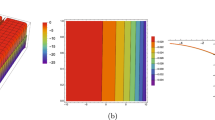Abstract
To study the full seismic, ocean acoustic, and tsunami wavefields generated by subduction zone earthquakes, we have developed a provably stable and accurate finite difference method that couples an elastic solid to a compressible fluid subject to gravitational restoring forces. We introduce a linearized dynamic traction-free boundary condition for the moving sea surface that is valid for small amplitude perturbations about an ocean initially in hydrostatic balance. We derive an energy balance for the continuous problem and then use high-order summation-by-parts finite difference operators and weak enforcement of boundary conditions to derive an equivalent discrete energy balance. The discrete energy balance is used to prove stability of the numerical scheme, and stability and accuracy are verified through convergence tests. The method is applied to study tsunami generation by time-dependent rupture on a thrust fault in an elastic solid beneath a compressible ocean. We compare the sea surface evolution in our model to that predicted by the standard tsunami modeling procedure, which assumes seafloor uplift occurs instantaneously and neglects compressibility of the ocean. We find that the leading shoreward-traveling tsunami wave in our model has a noticeably smaller amplitude than that predicted by the standard approach.
Similar content being viewed by others
References
Carpenter, M.H., Gottlieb, D., Abarbanel, S.: Time-stable boundary conditions for finite-difference schemes solving hyperbolic systems: methodology and application to high-order compact schemes. J. Comput. Phys. 111(2), 220–236 (1994)
Carpenter, M.H., Kennedy, C.A.: Fourth-order 2N-storage Runge-Kutta schemes. NASA TM 109112 (1994)
Gustafsson, B.: The convergence rate for difference approximations to mixed initial boundary value problems. Math. Comput. 29(130), 396–406 (1975)
Gustafsson, B., Kreiss, H.O., Oliger, J.: Time-dependent problems and difference methods, vol. 121. Wiley, New York (2013)
Kajiura, K.: The leading wave of a tsunami. Bull. Earthq. Res. Inst. 43, 535–571 (1963)
Kozdon, J.E., Dunham, E.M.: Rupture to the trench: dynamic rupture simulations of the 11 March 2011 Tohoku earthquake. Bull. Seism. Soc. Am. 103(2B), 1275–1289 (2013)
Kozdon, J.E., Dunham, E.M.: Constraining shallow slip and tsunami excitation in megathrust ruptures using seismic and ocean acoustic waves recorded on ocean-bottom sensor networks. Earth Planet. Sci. Lett. 396, 56–65 (2014)
Kozdon, J.E., Dunham, E.M., Nordström, J.: Interaction of waves with frictional interfaces using summation-by-parts difference operators: weak enforcement of nonlinear boundary conditions. J. Sci. Comput. 50(2), 341–367 (2012)
Kozdon, J.E., Dunham, E.M., Nordström, J.: Simulation of dynamic earthquake ruptures in complex geometries using high-order finite difference methods. J. Sci. Comput. 55(1), 92–124 (2013)
Kreiss, H.O.: Initial boundary value problems for hyperbolic systems. Commun. Pure Appl. Math. 23(3), 277–298 (1970)
Kreiss, H.O., Scherer, G.: Finite element and finite difference methods for hyperbolic partial differential equations. In: Mathematical aspects of finite elements in partial differential equations, pp. 195–212. Academic Press (1974)
Kundu, P., Cohen, I., Dowling, D.: Fluid mechanics. Academic Press, New York (2012)
Maeda, T., Furumura, T.: FDM simulation of seismic waves, ocean acoustic waves, and tsunamis based on tsunami-coupled equations of motion. Pure Appl. Geophys. 170(1-2), 109–127 (2013)
Maeda, T., Furumura, T., Noguchi, S., Takemura, S., Sakai, S., Shinohara, M., Iwai, K., Lee, S.J.: Seismic and tsunami wave propagation of the 2011 off the pacific coast of Tohoku earthquake as inferred from the tsunami-coupled finite difference simulation. Bull. Seism. Soc. Am. 103(2B), 1456–1472 (2013)
Maeda, T., Furumura, T., Sakai, S., Shinohara, M.: Significant tsunami observed at ocean-bottom pressure gauges during the 2011 off the Pacific coast of Tohoku earthquake. Earth Planets Space 63, 803–808 (2011)
Marano, K.D., Wald, D.J., Allen, T.I.: Global earthquake casualties due to secondary effects: a quantitative analysis for improving rapid loss analyses. Nat. Hazards 52(2), 319–328 (2010)
Matsumoto, H., Inoue, S., Ohmachi, T.: Some features of water pressure change during the 2011 Tohoku earthquake. Proceedings of the International Symposium on Engineering Lessons Learned from the 2011 Great East Japan Earthquake (2012)
Mori, N., Takahashi, T.: The 2011 Tohoku earthquake tsunami joint survey group: nationwide post event survey and analysis of the 2011 Tohoku earthquake tsunami, vol. 54 (2012)
Saito, T.: Dynamic tsunami generation due to sea-bottom deformation: analytical representation based on linear potential theory. Earth Planets Space 65, 1411–1423 (2013)
Segall, P.: Earthquake and volcano deformation. Princeton University Press, Princeton (2010)
Sells, C.C.L.: The effect of a sudden change of shape of the bottom of a slightly compressible ocean. Philos. Trans. R. Soc. Lond. Ser. A, Math. Phys. Sci. 258(1092), 495–528 (1965)
Strand, B.: Summation by parts for finite difference approximations for d/dx. J. Comp. Phys. 110(1), 47–67 (1994)
Trugman, D.T., Dunham, E.M.: A 2d pseudodynamic rupture model generator for earthquakes on geometrically complex faults. Bull. Seism. Soc. Am. 104(1), 95–112 (2014)
Yamamoto, T.: Gravity waves and acoustic waves generated by submarine earthquakes. Int. J. Soil Dyn. Earthq. Eng. 1(2), 75–82 (1982)
Author information
Authors and Affiliations
Corresponding author
Additional information
This work was supported by the National Science Foundation (EAR-1255439) and the Alfred P. Sloan Foundation (BR2012-097).
Rights and permissions
About this article
Cite this article
Lotto, G.C., Dunham, E.M. High-order finite difference modeling of tsunami generation in a compressible ocean from offshore earthquakes. Comput Geosci 19, 327–340 (2015). https://doi.org/10.1007/s10596-015-9472-0
Received:
Accepted:
Published:
Issue Date:
DOI: https://doi.org/10.1007/s10596-015-9472-0




